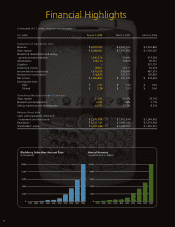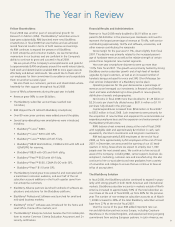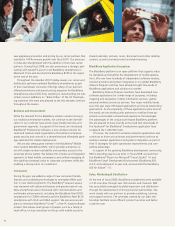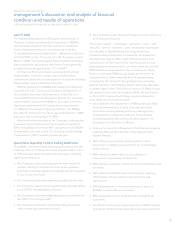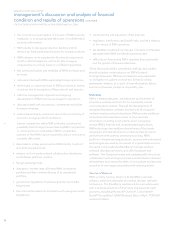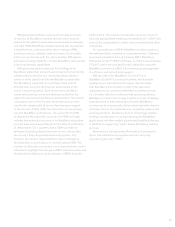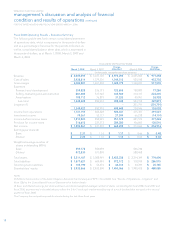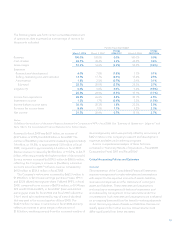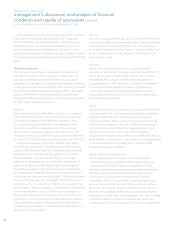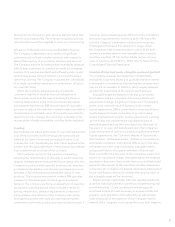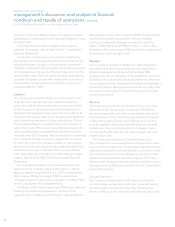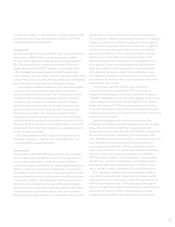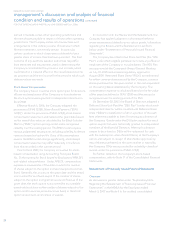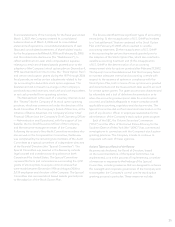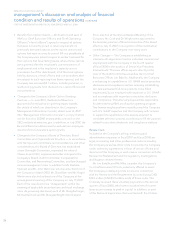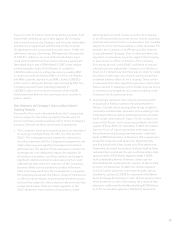Blackberry 2008 Annual Report Download - page 19
Download and view the complete annual report
Please find page 19 of the 2008 Blackberry annual report below. You can navigate through the pages in the report by either clicking on the pages listed below, or by using the keyword search tool below to find specific information within the annual report.17
performance. The number of subscriber accounts does not
have any standardized meaning prescribed by U.S. GAAP and
may not be comparable to similar metrics presented by other
companies.
An important part of RIM’s BlackBerry wireless solution is
the software that is installed on corporate servers. Software
revenues include fees from (i) licensing RIM’s BlackBerry
Enterprise Server™ (“BES”) software; (ii) client access licenses
(“CALs”), which are charged for each subscriber using the
BlackBerry service via a BES; (iii) maintenance and upgrades
to software; and (iv) technical support.
RIM also offers the BlackBerry Connect™ and
BlackBerry Built-In™ Licensing Programs, which enable
leading device manufacturers to equip their handsets
with BlackBerry functionality, in order that users and
organizations can connect to BlackBerry wireless services
on a broader selection of devices and operating systems.
BlackBerry Connect technology enables a variety of leading
manufacturers to take advantage of proven BlackBerry
architecture to automatically deliver email and other data to
a broader choice of wireless devices, operating systems and
email applications. BlackBerry Built-In technology enables
leading manufacturers to incorporate popular BlackBerry
applications into their mobile phones and handheld devices
in addition to supporting “push”-based BlackBerry wireless
services.
Revenues are also generated from sales of accessories,
repair and maintenance programs and non-recurring
engineering services (“NRE”).
RIM generates hardware revenues from sales, primarily
to carriers, of BlackBerry wireless devices, which provide
users with the ability to send and receive wireless messages
and data. RIM’s BlackBerry wireless devices also incorporate
a mobile phone, a personal information manager (PIM)
including contact, calendar, tasks and memo functionality,
which can synchronize with the user’s desktop PIM system,
and web-browsing capability. Certain BlackBerry devices also
include multimedia capabilities.
RIM generates service revenues from billings to its
BlackBerry subscriber account base primarily from a monthly
infrastructure access fee to a carrier/distributor where a
carrier or other distributor bills the BlackBerry subscriber.
The BlackBerry subscriber account base is the total of
all subscriber accounts that have an active status at the
end of a reporting period. Each carrier instructs RIM to
create subscriber accounts and determines whether the
subscriber account should have an active status. That carrier
is charged a service fee for each subscriber account each
month with substantially all service fees having no regard
to the amount of data traffic the subscriber account passes
over the BlackBerry architecture. If a carrier informs RIM
to deactivate the subscriber account, then RIM no longer
includes that subscriber account in its BlackBerry subscriber
account base and ceases billing from the date of notification
of deactivation. On a quarterly basis, RIM may make an
estimate of pending deactivations for certain carriers that
do not use a fully-integrated provisioning system. It is,
however, the carrier’s responsibility to report changes to
the subscriber account status on a timely basis to RIM. The
number of subscriber accounts is a non-financial metric and is
intended to highlight the change in RIM’s subscriber base and
should not be relied upon as an indicator of RIM’s financial



